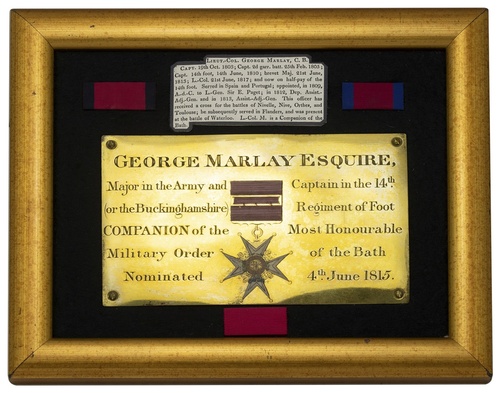
Auction: 25001 - Orders, Decorations and Medals
Lot: 418
(x) The Most Honourable Order of the Bath, C.B. (Military) Companion’s, Chapel Stall Plate, gilded brass with engraved and painted image of a C.B. Badge, inscribed 'George Marlay Esquire, Major in the Army and Captain in the 14th (or the Buckinghamshire) Regiment of Foot, Companion of the Most Honourable Military Order of the Bath, Nominated 4th June 1815.', 190mm x 114mm, corners pierced for attachment and screwed into frame, presented in a gold display frame with short biography and three short lengths of riband, minor chip to paint, otherwise very fine
George Marlay was born in 1791, the son of Major George Marlay of York House in Twickenham and his wife Lady Catherine Butler, daughter of the 2nd Earl of Lanesborough. Major Marlay served for many years with the 62nd Regiment of Foot, including during the American War of Independence where he was captured at the Battle of Sarasota. George Marlay Jr. followed in his father's footsteps and was made Captain on 19 October 1803 at the tender age of twelve - his commission likely being purchased by his father. Just two years later he was made Captain of the 2nd Garrison Battalion on 25 February 1805, but did not become a Captain in the 14th Foot until 14 June 1810 when he was of age.
In 1809 young Marlay had been appointed Aide-de-Camp to Lieutenant-General Sir Edward Paget, and was promoted as Lieutenant-General Paget's Deputy Assistant Adjutant General in 1812 and Assistant Adjutant General in 1813. That same year he was also advanced Major, appearing in the London Gazette on 3 July.
Marlay served with his Regiment at the Battle of Waterloo as a Captain of the 3rd Battalion, which was part of the 4th Division under Lieutenant-General Sir Charles Colville. The 3rd Battalion itself was commanded by Lieutenant-Colonel Francis Tidy and was notably comprised mostly of young, inexperienced soldiers. Their conduct on the field of Waterloo is noted in Richard Cannon's Historical Records of the British Army - 14th Regiment of Foot:
'The battalion was composed of young soldiers, who had never before been under fire, but their bearing reflected honour on the corps to which they belonged. During the heat of the conflict, when the thunder of cannon and musketry, the occasional explosion of caissons, the hissing of balls, shells, and grape shot, the clash of arms, the impetuous noise and shouts of the soldiery, produced a scene of carnage and confusion impossible to describe, a staff officer rode up to Lieutenant-Colonel Tidy, and directed him to form square; this was scarcely completed when the glittering arms of a regiment of cuirassiers were seen issuing from the smoke. The French horsemen paused for a moment at the sight of the scarlet uniforms of the Fourteenth, and then turned to the right to attack a regiment of Brunswickers; but a volley from the Brunswick square repulsed the enemy, and Lieutenant-Colonel Tidy, with the view of giving confidence to the young soldiers of the Fourteenth, drew their attention to the facility with which infantry could repulse cavalry. The French cuirassiers rallied, and appeared inclined to charge the Fourteenth, but were intimidated by the steady and determined bearing of the battalion.'
Lieutenant-General Colville himself observed 'the very young third battalion of the Fourteenth, in this its first trial, displayed a steadiness and gallantry becoming of veteran troops.'
Marlay was nominated as a Companion of the Order of the Bath just days ahead of the famous battle. He was later placed on half pay the following year on 25 March 1816, the same year during which the 3rd Battalion was disbanded, and later received his final promotion to Lieutenant-Colonel on 21 June 1817. At some stage of his service, Marlay spent a length of time in India where his heath declined and contributed to his premature demise.
Marlay married Catherine Louisa Tisdall at All Souls' Church in Marylebone, London on 7 April 1828. The couple had three children from 1830-1, though their eldest son James was to tragically drown aged just fourteen. Their daughter Catherine later married the 7th Duke of Rutland, and their son Charles Brinsley donated a valuable collection of artworks to Cambridge's Fitzwilliam Museum, dubbed 'The Marlay Collection'.
Marlay was just thirty-nine years old when he died at London on 8 June 1830 due to 'a diseased state of the lungs' and 'liver contracted in India'. He was interred alongside his mother, father, and eventually his son at St Mary's Church in Twickenham - now the public park Holly Road Garden of Rest. For unknown reasons George and his son were re-interred together in Highgate Cemetery in 1852, where they were later joined by his wife.
Marlay is entitled to a Waterloo Medal and an Army Gold Cross for Nivelle, Nive, Toulouse and Orthes; sold together with copied research.
Subject to 5% tax on Hammer Price in addition to 20% VAT on Buyer’s Premium.
Estimate
£800 to £1,200
Starting price
£600




